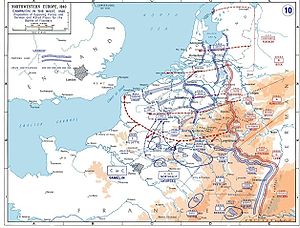The Dyle
| Dyle-Breda Plan/Breda variant | |
|---|---|
| Part of the Second World War | |

Western Front campaign, 1940
|
|
| Operational scope | Strategic |
| Location |
South-west Netherlands, central Belgium, northern France Coordinates: 50°51′00″N 04°21′00″E / 50.85000°N 4.35000°E |
| Planned | 1940 |
| Planned by | Maurice Gamelin |
| Commanded by | Alphonse Georges |
| Objective | Defence of the Netherlands, Belgium and France |
| Date | 10 May 1940 |
| Executed by | French 1st Army Group British Expeditionary Force Belgian Army |
| Outcome | Defeat |
The Dyle Plan or Plan D was the plan of the Commander-in-Chief of the French Army, Général d'armée Maurice Gamelin to defeat a German attempt to invade France through Belgium; the Dyle (Dijle) river is 86 km (53 mi) long, from Houtain-le-Val through Flemish Brabant and Antwerp. Gamelin intended French, British and Belgian troops to halt a German invasion force along the line of the river. The Franco-Belgian Accord of 1920 had co-ordinated communication and fortification efforts of both armies but after the German Remilitarization of the Rhineland on 7 March 1936, the Belgian government let the accord lapse, to adopt a policy of strict neutrality, with the German Army (Heer) on the Belgian border.
French doubts about the Belgian army led to uncertainty about whether French troops could move fast enough into Belgium to avoid an encounter battle and fight a defensive battle from prepared positions. The Escaut Plan/Plan E and Dyle Plan/Plan D were devised for a forward defence in Belgium, along with a possible deployment on the French-Belgian border to Dunkirk. Gamelin chose the Escaut Plan then substituted Plan D for an advance to the line of the Dyle, which was 70–80 km (43–50 mi) shorter. Some officers at Grand Quartier Général (GQG, general headquarters of the French Army) doubted that the French could arrive before the Germans.
German dissatisfaction with the campaign plan Fall Gelb (Case Yellow), increased over the winter of 1939–1940 and then the Mechelen Incident occurred on 10 January 1940, when a German aircraft landed in Belgium carrying plans for the invasion. The incident was a catalyst for the doubts and led to the Manstein Plan, a bold, almost reckless gamble, for an attack further south through the Ardennes. The attack on the Low countries became decoy to lure the Allied armies, the easier to outflank them from the south.
...
Wikipedia
